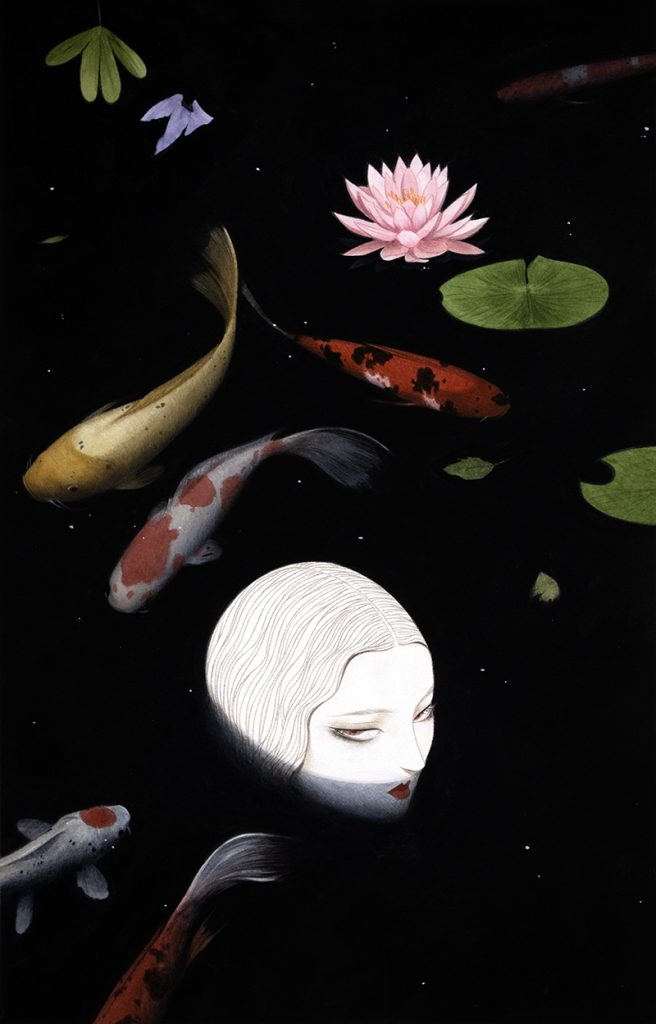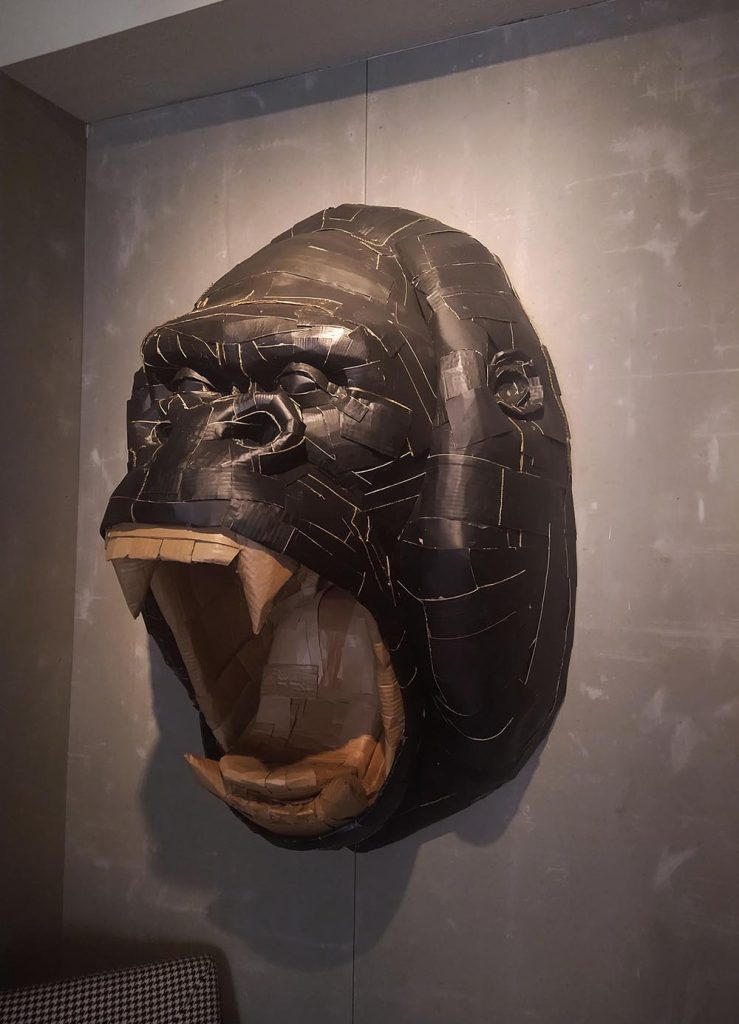
David B. Smith and Kris Lewis
Los Angeles-based painter Kris Lewis opened his most recent show at the David B. SmithGallery in Denver on May 20th. Lewis masterfully blends traditional portraiture with a stylizedmodern edge, resulting in emotion laden subjects brimming with mystery and depth. Hi-Fructosecaught up with the artist to ask a few questions about his work. – Marisa Ware
I’m always curious when I hear that an artist grew up somewhere unexpected, such as yougrowing up in New Jersey. Where did your earliest inspiration and instruction come from? Arethere traces of your New Jersey roots somewhere in your work?
I remember my father and my sister both teaching me how to draw. I must have been aroundfour years old when I first remember my “stick figures” being slightly different than thoseof other children my age. I had a pretty good understanding of the contour shape of the figureand form. Occasionally, I will paint some of my favorite areas, particularly around the Jerseyshore. Growing up in a family of fisherman, boaters, and surfers, I spent the majority of myleisure time in and around the ocean and Barnegat Bay.

I know that your Latvian heritage is important to you. What’s Latvian culture like anyway? Howdoes it influence your paintings?
The strength of my family is tied to the Latvian culture itself. Latvians are incrediblystrong, proud people, very hard workers – and I tend to reflect those characteristics in mysubjects. Latvian culture is very much grounded in nature and art – the national heros are poetsand painters, and holidays and daily life alike revolve around a respect for the earth and its powerand beauty.

At the opening, your brother told me a story about how your career got jump-started whenwill.i.am from the Black Eyed Peas bought a piece of yours called “Michael Jackson in a Box”or something of the sort, then you ended up doing the art for his solo album. Can you retell thatstory briefly please?
I had a piece in a small gallery in LA’s Atwater Village which happened to be a few doors downfrom the Black Eyed Peas studio, and will.i.am ended up buying “Jacko in the Box.” About ayear and a half later, he commissioned me for a piece to hang in his private studio, a painting thatI created from a picture of his grandmother as a girl jumping rope in her old neighborhood. Thisbegan a relationship that has lead to doing album art, curating two shows coinciding withthe Grammy Awards, and working on a multi-dimensional video that will be released later thisyear.

You studied illustration, but your paintings show such an understanding and mastery oftraditional portraiture. Where did you learn that skill?
As an illustration major at the University of the Arts in Philadelphia, we had an intense,traditional program in the fundamentals of drawing and painting which we were expected tomaster before branching off into our own unique styles. We had a program put together byIllustration head Mark Tocchet that was aimed at giving us well-rounded instruction in manydifferent disciplines, guided by talented instructors, who were also working professionals, suchas Paul King, Tim O’Brien, and Brian Biggs.

Do you paint from models, and if so, how do you choose them? Many of your women seem tohave this ineffably similar quality to them.
Yes. I choose my models based on the feel of the piece I’m working on. The sketches anddrawings I create before before beginning the actual painting dictate the model choice. I thinkthat the quality you’re referring to is an effect of my stylization of the figures.

Along the same lines, a lot of the women in your paintings seem to be expressing an analogousemotion. It’s difficult to pin down exactly what they’re feeling, and that leaves it open foryour audience to interpret themselves. Is there a thematic emotion that you are intentionallytrying to portray in many of your paintings? What are the women in your paintings trying tocommunicate?
As you said, I do intend to “leave it open” for my audience to interpret the emotions of a piecethemselves. The way I portray a subject is based on my own feelings and personal experiences,and I don’t expect or intentionally try to bring the viewer into that same experience but one oftheir own.

Another question about your women: I noticed that many of them have elongated necks. Thisis something that seems to be prevalent in a lot of Pop Surrealist painters’ work. I’m sure thateveryone has different intentions behind why they do that- what’s yours?
It’s certainly an aesthetic choice, and any gesture or emphasis on certain areas of the figure isused to convey, for me, a specific feeling. The elongated neck conveys strength and confidence;there may be other features in a piece that contradict that, which lend to creating a multi-faceted,at times diametric subject.

I want to hear about the painting of the Scandinavian looking children standing in the woods. Ioverhead some people discussing it at your show, and everyone had a different interpretation oftheir emotion. Some people thought they looked distraught, others thought they looked defiant.Who are these kids; what’s their story?
They are the sons of two of our Latvian friends. Much like their parents, who are two of meand my girlfriend’s closest friends in Los Angeles, they are incredibly creative, good-heartedpeople. The boys have very distinct, strong personalities, and it has been amazing having thechance to watch them change and grow.

Another one of your paintings that really stood out was the African American man. I reallyliked how the detail in his face and hair was so crisp and vivid, and as you expanded out fromthat, from his clothes to the background, the detail faded. I also noticed that he was wearing alightning bolt pendant that a woman in another painting of yours was also wearing. What’s thedeal with that?
In Latvian culture, lightning and thunder are symbols of power, and it’s common for to me to putin muted pieces of symbolism to help describe and support the subject’s true personality.

Where do you find your inspiration? Besides art, what other elements of your life are the mostimportant to you?
I find my inspiration in personal relationships, the play between connection and disconnect to myenvironment, and my love of nature. The most important elements of my life are the love of myclose friends and family and being able to provide that back to them.

What’s next for you after this show? Where do you see your work heading?
I have a few group shows and solo shows planned, including working further with David B.Smith Gallery in Denver, Arcadia Gallery in New York City, and Zolla Lieberman Gallery inChicago. Just as when I begin a painting I am never sure where it will bring me, I don’t have aclear vision of where my work is heading… and leaving my options, interpretations, andopportunities open is just the way I like it.





